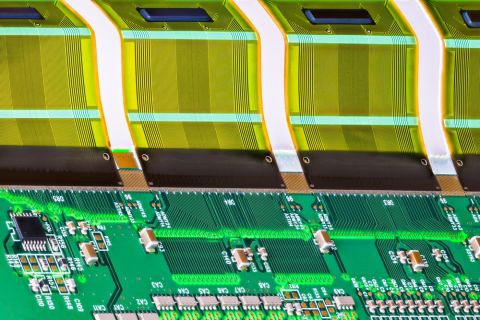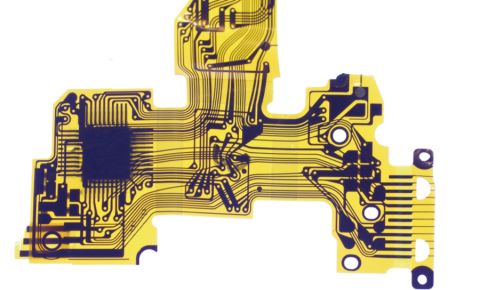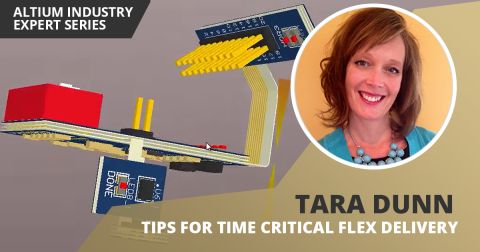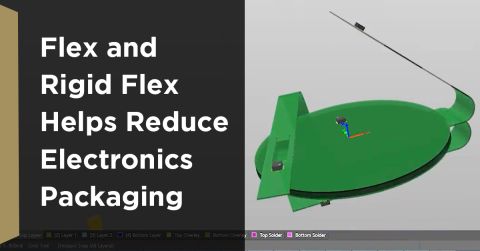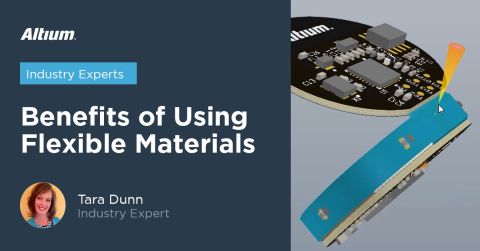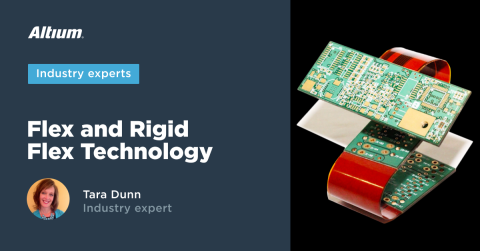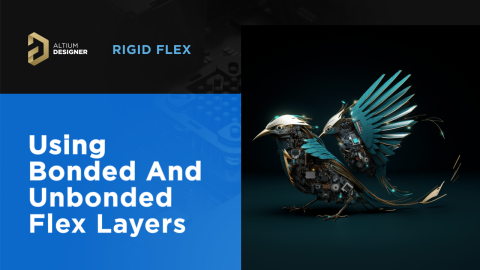Flex and Rigid-Flex PCB Applications

There are two basic reasons for designing a flex circuit into your product: to build a compact and efficiently assembled device, or to make the circuit dynamically integrated with the mechanical function of the product. You may, of course, lean on both of these reasons for justifying the use of flex circuits. On this note, let’s look at some rigid-flex PCB applications and design examples to see the issues that spring to mind when designing flex circuits.
Dynamic Flex Application Examples
Mechatronic Gantry
A very typical dynamic flex application, such as you might find in a 3D printer or CNC machine head, is a mechantronic gantry. In physically larger systems where electronic components need to follow the same motion as a mechanical element, this would be accomplished with separate rigid boards or modules, and these would be connected with cables. In smaller, sleeker packages, a flex ribbon makes more sense as it provides a low-profile assembly as well as the required motion.
Naturally, the example below would be laid along the X-axis gantry, and the z-axis tool head travels along it. The example below only shows two axes of motion here, and the gantry itself would move in the Y-axis.
The total length of the flex ribbon is the most extreme end-distance required in addition to the corners and bends. The corner that sits behind the moving z-axis tool head would adhere to the x-axis shuttle that moves along the gantry (probably on sleeve bearings). The ends would have stiffener added to terminate the flex ribbon section. For this type of application, it’s best to stick to single layer rolled-annealed copper and keep the bend radii as large as practically possible. This will help maximize the lifetime as the bend region is rolled along the length of the flex ribbon.

Example gantry flex design.
Gantry Fab Consideration: Panelizing
The example above raises a good question about fabrication and cost. Using a right-angled L-shaped circuit like this we could, for argument’s sake, fit six identical flex ribbons on a fabrication panel. This results in roughly 50% waste of the panel space, and if components were to be mounted on this particular flex circuit, also add to the tooling cost and time. An example panel made from this particular flex circuit in an embedded board array is shown below.

Embedded Board Array panelization of the CNC gantry flex circuit.
The good thing about flex is if we use the right materials and plan the overall assembly right, we can also create low-radius installation folds. Placing a static flex section with a permanent crease is a good alternative to using curved flex circuits as shown in the panel above, but only in certain circumstances. The following figure shows the same gantry design but with a creased 45° fold to replace the 90° corner shown in the previous version.

Gantry flex re-designed with static crease.
The fold becomes clearly useful once we look at the panel (shown below). To fabricate a flex circuit with this type of crease, we don't need to design a bend into the board. Instead, we can use a straight section in the flex PCB, so we can now line up an entire array of flex ribbons in a single panel. In this way, the yield increases significantly. The total cost per board will decrease due to the incrased yield per panel and then ease of tooling for pick-and-place assembly. However you may have this counteracted by having to place components on the opposite side at one end of the assembly, due to the fold.

Panel with the redesigned gantry board.
Rotational Devices
Take a look at the rigid-flex PCB layout shown below. In this layout, the flex layers are created using bends rather than a permanent crease. Notice the use of horizontal work guides in the PCB editor; this enables accurate design of the board outline based on curved circumferences of in-situ flex circuit sections. It also allows exact placement of flex circuit bending lines in the Board Planning Mode inside the PCB editor, which allows for accurate flex circuit bend simulations in 3D mode.

PCB layout for a rotational dynamic flex design. The flex ribbons can attached to a fixed housing or another component that will rotate with the central shaft in the assembly.
In this example, a stepper motor is to be mounted to an assembly such that the motor and it’s control printed circuit board will be in motion, while the shaft will be stationary. The flex circuits are designed to be terminated at the extreme ends to a fixed base assembly and folded into a cylinder shape, doubling back to allow bi-directional movement. 3D views of this design are shown below.

3D view of a rotating stepper motor control board. Longer “arms” would allow greater than 360° rotation of the motor and it’s control board.

The fully folded view of the assembly, including the 3D body of the stepper motor.
We can see the directions of mtoion and the anchored flex-circuit terminators to give you an idea of how this assembly will operate. This kind of arrangement makes it relatively easy to achieve greater than 360° of rotation. This example is hypothetical and shows a stepper motor, though this kind of design would be well suited to rotary sensor applications. The terminated rigid-flex sections could also mount to some components on the enclosure, as long as the enclosure was rotating, giving a simple way to provide a connection back to the rigid control board section.
Static Flex Application Examples
Planar Magnetics (Transformers and Inductors)
The use of flex and rigid-flex circuits for integrated planar magnetics is rising in popularity. Using flex-circuits for planar magnetics has some distinct advantages. The polyImide film comes in thicknesses that allow very high isolation of windings, as well as high temperature stability that makes it suitable for hot enamel potting processes. From a loss standpoint; using etched copper traces requires the traces be wider, but this can easily reduce eddy-current losses because the additional impedance from the skin effect will be reduced.

The un-rolled solenoid turns of a four winding inductor.
An interesting entry and exit scheme for a rolled air-core inductor is shown below. In this rolled flex PCB assembly, the end of each winding overlaps with the beginning of the next winding. This could be done to increase the number of turns versus simply having multiple separate windings.

Rolled inductor windings.
18 Layers for the Price of 2
The natural extension of this concept is to include some flex layers in your converter design with the intent of folding them over each other. In the example shown below, a 2-layer flex circuit transformer design is shown, where a single E18 planar ferrite core protrudes through cutouts in the end terminator region (on the left side). This idea could be arbitrarily extended (albeit with practical limits of the thickness of the final folded board). In figure 11, the top and bottom copper layers on double-sided flex yield 18 usable layers for the transformer windings.
Around each of the core center-leg cutouts, you can make a single turn for an inductor winding. Snaking the track around a side-leg will give you half a turn, while the return path provides the other half turn in a transformer coil; together, the folded conductor sections form a set of stacked current loops that can generate and receive a magnetic field.

Overhead view of a flex-circuit transformer. A single heavy current winding is shown on the top layer, and six lighter current windings are routed on the bottom layer.
This could be confusing though, because you have to keep track of the proper winding directions with respect to each folded section’s relation to the ferrite core geometry. Given that this whole flex circuit will fold orthogonally, I’ve added arrows on the Mechanical 1 layer of the design facing opposite to each adjacent winding layer to remind me which way to route the copper. This is shown below for clarity.

Mechanical 1 layer showing the board outline and winding direction arrows for guidance.
The final core-and-flex assembly is shown below. Note that this could be integrated within a rigid-flex design where the majority of the circuit is on a rigid 2-layer Printed Circuit Board, with the flex part being used to get the additional layers needed for all the core windings. Of course, there is going to be a cost trade-off between using a large flex area versus just adding heaps of layers to a rigid-only design.

The final completely folded-up transformer, with 3D model of the Ferroxcube E18 ferrite magnetic core through the cutouts.
Multi-Layer Rigid-Flex
For many military, aerospace, or similar high-density designs that require compact, reliable assemblies in tight spaces, it’s hard to avoid using several layers of flex circuits between rigid board areas. Even more so, this is necessary with high-speed digital designs, due to the need for shielding or plane layers between busses traversing the flex regions. The challenge here is that to maintain a good degree of flexibility. The number of flex circuit layers has to be kept to a minimum, usually two copper layers over a single polyimide substrate with polyimide coverlays.
In “normal” designs, the length of the flex-circuit sections is the same for overlapping flex regions. This means you end up with the situation shown below, where the folds can produce significant tension in the flex areas between rigid boards once placed into the final assembly.

Tension in the outer flex circuit, and compression of the inner circuit, will result when multiple overlapping flex layers are designed with the same length. Notice the “squeeze out” of the adhesive bead used in this design, right where the flex enters the rigid section.
Most specialist rigid-flex board fabricators at this point would tell you to use “bookbinder” construction. Bookbinder construction is a viable method where the in-situ radii of the flex circuit bends are used to determine the correct length for each flex circuit and substrate combination in the layer stack. An example illustration of the concept is shown in the IPC-2223b excerpt below.

Bookbinder construction [Source: IPC-2223B, 2008 p26].
You can tell immediately this method is going to cost money and increase the challenge of design. Often, a better alternative is to use the same length and radius flex-circuits, but separate the different flex circuit layers so that they do not overlap each other. An example of this is shown below.

Alternative bookbinder construction. Normally, the flex sections might overlap and would require different lengths to maintain low tension/compression. In this alternative, the flex sections are placed in different regions across the edge of the rigid sections so that they no longer need to overlap.
Ultra-Tight Bends Without Sacrificing Layer Count
With some creative design choices along the bend region, it's possible to get very tight bends without losing copper layers.
The tiny board shown below uses an "S" shaped ribbon to define bends and decrease the minimum bend radius along the edge of the stiffened regions. It’s not visible in this photo, but there are components mounted on sections that had thin stiffener adhered on the back side of the board.

Getting essentially 180° bend radius with multiple copper layers.
This concept can be extended in multiple directions. The PCB design shown below is an ultra-flexible PCB display board. You can see the many LEDs in a matrix on the wider, stiffer sections. The whole assembly is rigid in those sections only because of the sheer number of copper and PI film layers laminated together. Again, using S-bends between those LED matrix regions allows this assembly to more easily bend into a curved housing.

X-Y S-bend flex array.
Take this concept even further, and you have the very compact design shown below. The flex-circuit sections in this example contain 8 layers. Such flex circuits would normally not be flexible if placed as direct ribbons between rigid sections. However, using the myriad of S-bends (notice the top flexible material layers are all solid copper for shielding!) allows this to bend enough to go into the final mechanical housing, even with hundreds of high speed memory and display connections.

8 Layers of flex, plus 4 additional rigid PCB layers. Notice the top layer of flex is entirely copper pour for shielding. Notice also the protective adhesive around the edges of the rigid-to-flex interfaces.
Designing for any rigid-flex PCB application is easy with the complete set of PCB design and manufacturing features in Altium Designer®. Once you're ready to release your design data to your manufacturer, you can easily share and collaborate on your designs through the Altium 365™ platform. Everything you need to design and produce advanced electronics can be found in one software package.
We have only scratched the surface of what is possible to do with Altium Designer on Altium 365. Start your free trial of Altium Designer + Altium 365 today.
